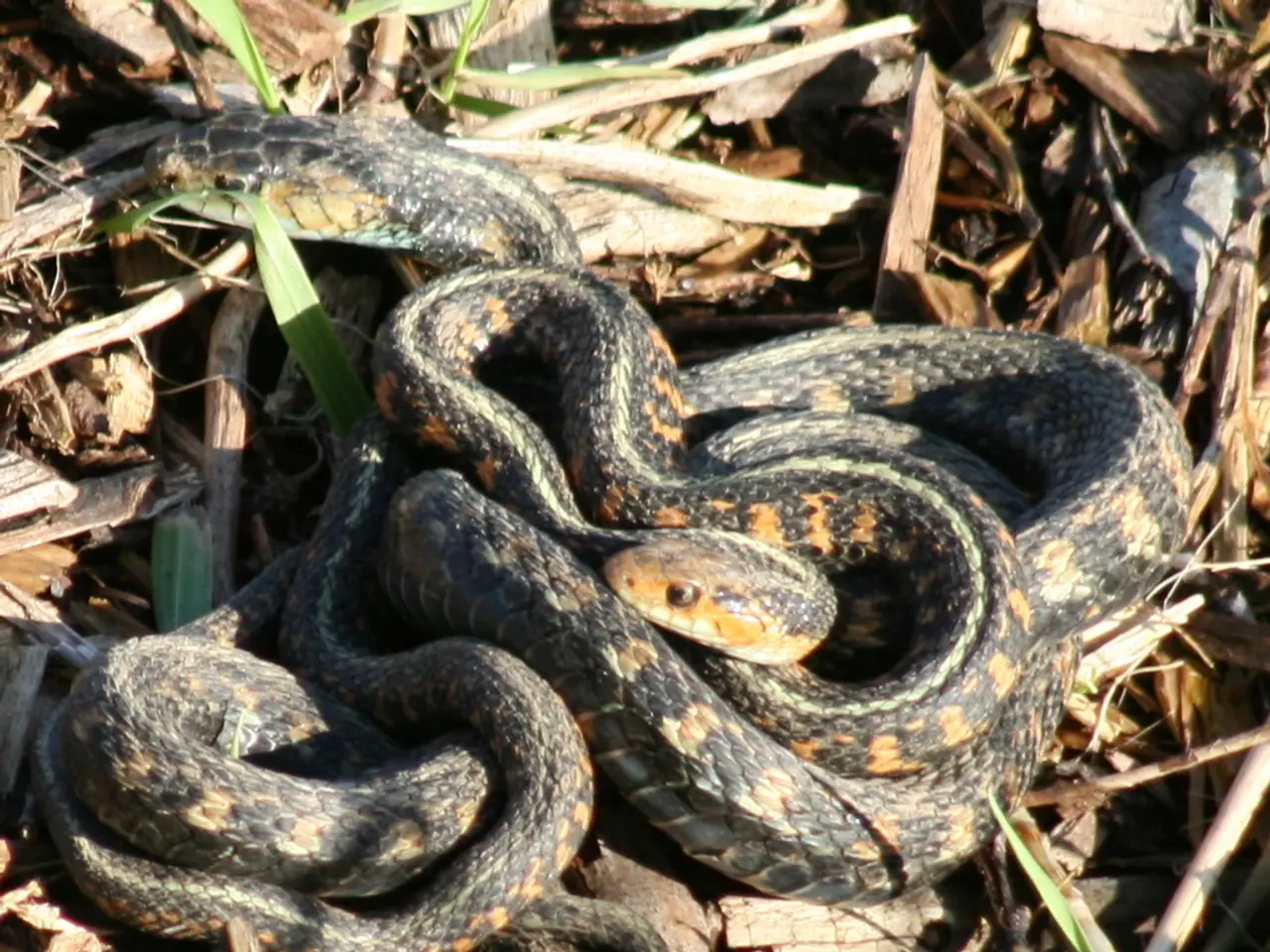Summarizing Dangerous Summer Risks for Tourists at Particular Georgia Lakes
Georgia's lakes are known for their natural beauty, but some of them are also home to a diverse population of snakes. Here's a guide to help you navigate the snake-infested lakes in the state.
Snake-Infested Lakes in Georgia
The WorldAtlas has ranked some of Georgia's most popular tourist destinations as the most snake-infested lakes. Among these are Lake Hartwell, Lake Allatoona, Lake Sinclair, and Lake Lanier. These lakes host a variety of snake species, both venomous and non-venomous.
Lake Hartwell
Spanning 56,000 acres on the Georgia-South Carolina border, Lake Hartwell is particularly noted for its high snake population. It hosts both non-venomous and venomous species, especially the eastern copperhead and timber rattlesnake. The eastern copperhead is the most common venomous snake here, identifiable by its brown colour and hourglass markings.
Lake Allatoona
Another heavily snake-infested lake, Lake Allatoona contains at least five common snake species. Although many are non-venomous, Georgia's venomous snakes, including the copperhead, cottonmouths, timber rattlesnakes, eastern diamond-backed rattlesnakes, pygmy rattlesnakes, and eastern coral snakes, are also present.
Lake Sinclair
Known for common watersnakes, which are non-venomous and excellent swimmers, Lake Sinclair is less dangerous to humans. Venomous snakes are not commonly highlighted there.
Lake Lanier
Lake Lanier has several snake species like the black rat snake but no venomous snakes reported around the lake.
Common Venomous Snake Species in Georgia
- Eastern Copperhead (Agkistrodon contortrix): Most common at Lake Hartwell.
- Timber Rattlesnake (Crotalus horridus): Also present at Lake Hartwell.
- Cottonmouths (Agkistrodon piscivorus): Both Northern and Florida cottonmouths occur in Georgia.
- Eastern Diamond-backed Rattlesnake (Crotalus adamanteus)
- Pygmy Rattlesnake (Sistrurus miliarius)
- Eastern Coral Snake (Micrurus fulvius)
All these venomous species have the potential to inhabit or be found near water bodies in Georgia, though their abundance varies by lake and region.
Safety Tips
If you spot a snake while visiting these lakes, it's important to remain calm and back away slowly. Avoid swimming during dusk and dawn, as snakes are more active during these hours. Staying on designated beaches can help reduce snake encounters.
In case of a snakebite, keep the bite below the heart and seek immediate medical attention. Pack a basic first-aid kit and know the location of the nearest hospital, as most ERs carry antivenom. If you're unsure about a situation, the Georgia Poison Center can provide advice.
During the summer breeding season, Georgia's lakes see an uptick in snake activity. Caution is advised during warmer months, particularly around shorelines and wooded areas.
For alternative snake-free swimming options, consider visiting Lake Blue Ridge in the Chattahoochee National Forest or coastal escapes like Jekyll or Tybee Island.
Georgia has the largest aquarium in the country located in Atlanta, providing a controlled environment for nature interaction. This can be a great alternative for those who prefer to avoid encounters with wild snakes.
[1] WorldAtlas. (2021). The Most Snake-Infested Lakes in Georgia. Retrieved from https://www.worldatlas.com/articles/the-most-snake-infested-lakes-in-georgia.html [2] Georgia Department of Natural Resources. (n.d.). Snakes of Georgia. Retrieved from https://georgiawildlife.com/fishing/fishing-regulations/snakes-of-georgia [3] Georgia Department of Natural Resources. (n.d.). Lake Hartwell. Retrieved from https://georgiawildlife.com/hunting/wildlife-management-areas/lake-hartwell [4] Georgia Department of Natural Resources. (n.d.). Lake Allatoona. Retrieved from https://georgiawildlife.com/hunting/wildlife-management-areas/lake-allatoona [5] Georgia Department of Natural Resources. (n.d.). Lake Sinclair. Retrieved from https://georgiawildlife.com/hunting/wildlife-management-areas/lake-sinclair [6] Georgia Department of Natural Resources. (n.d.). Lake Lanier. Retrieved from https://georgiawildlife.com/hunting/wildlife-management-areas/lake-lanier
When planning a trip to Georgia's picturesque landscapes, remember to check travel guides for advice on the state's infamously snake-infested lakes such as Lake Hartwell, Lake Allatoona, Lake Sinclair, and Lake Lanier. To better understand the diversity of these snakes, browse lifestyle articles on outdoor-living and home-and-garden websites that provide insights into the various venomous and non-venomous snake species thriving in these water bodies.




